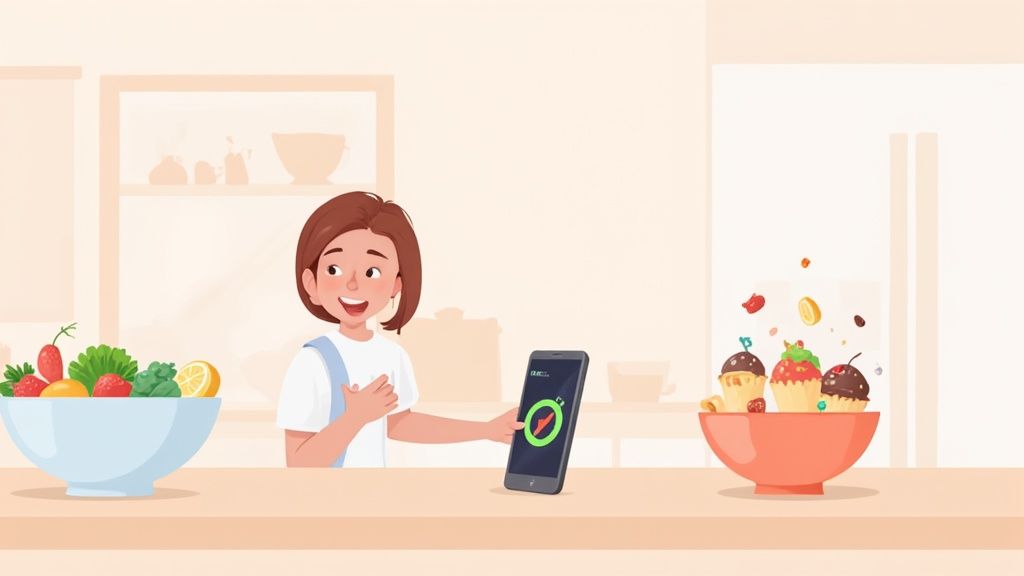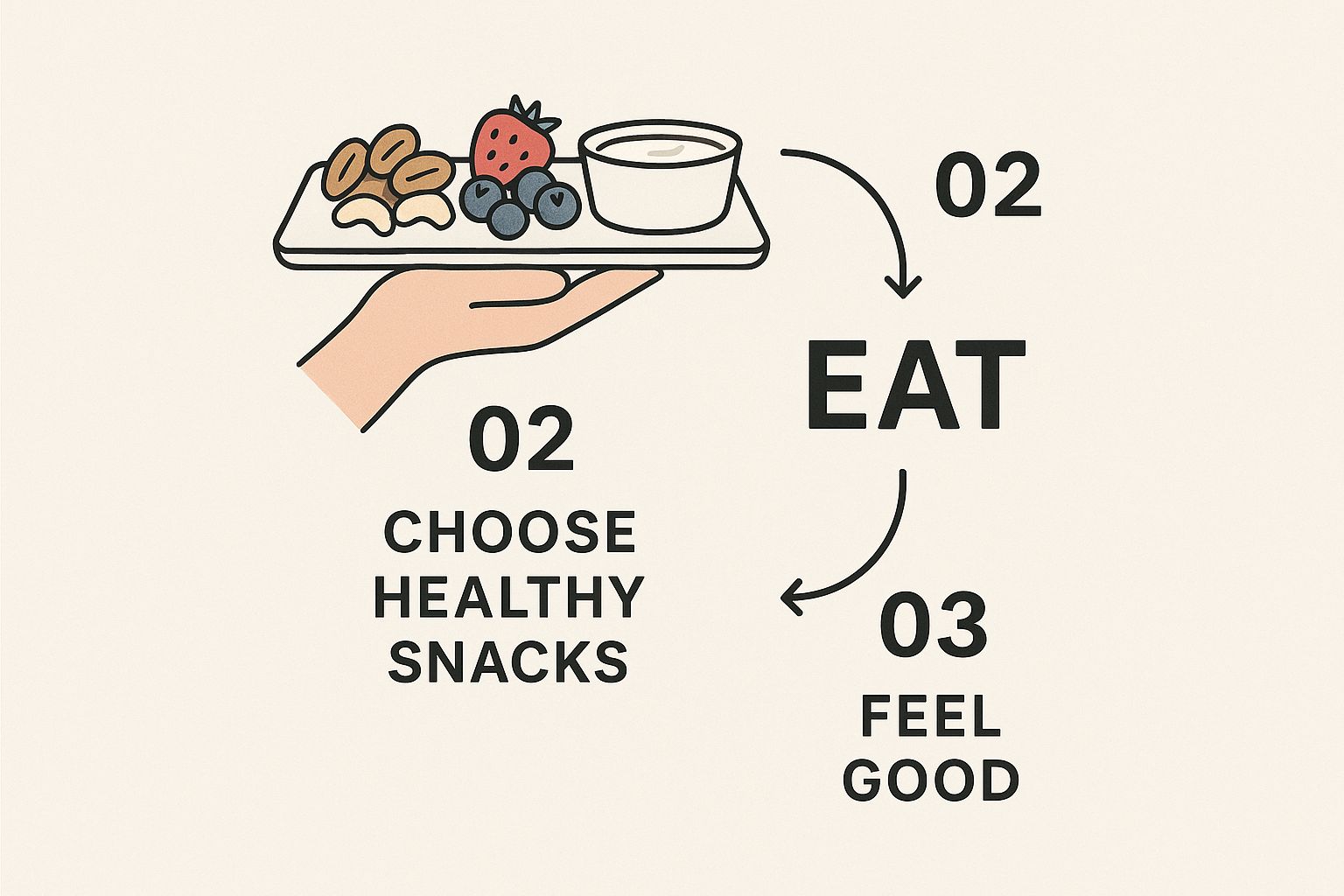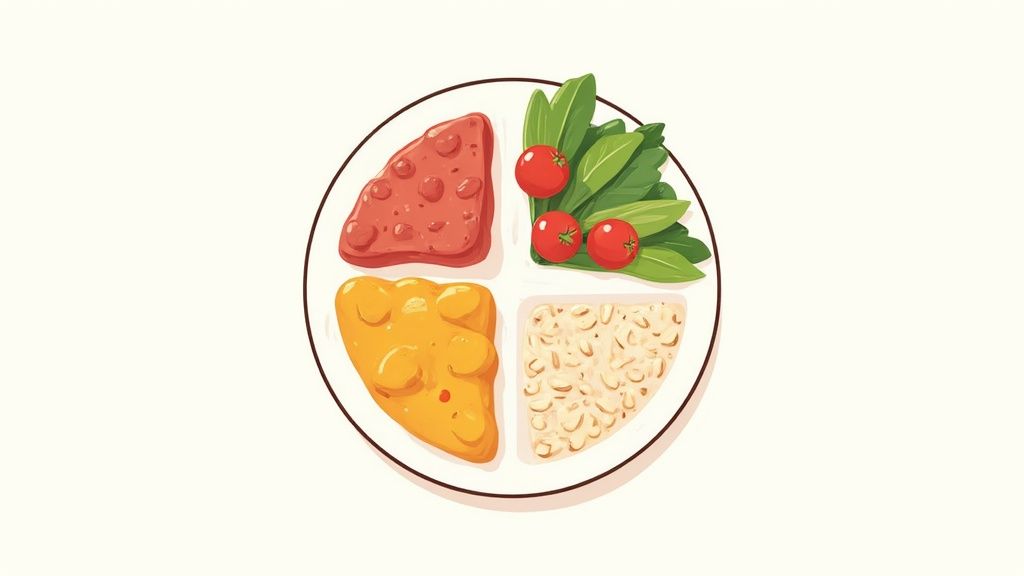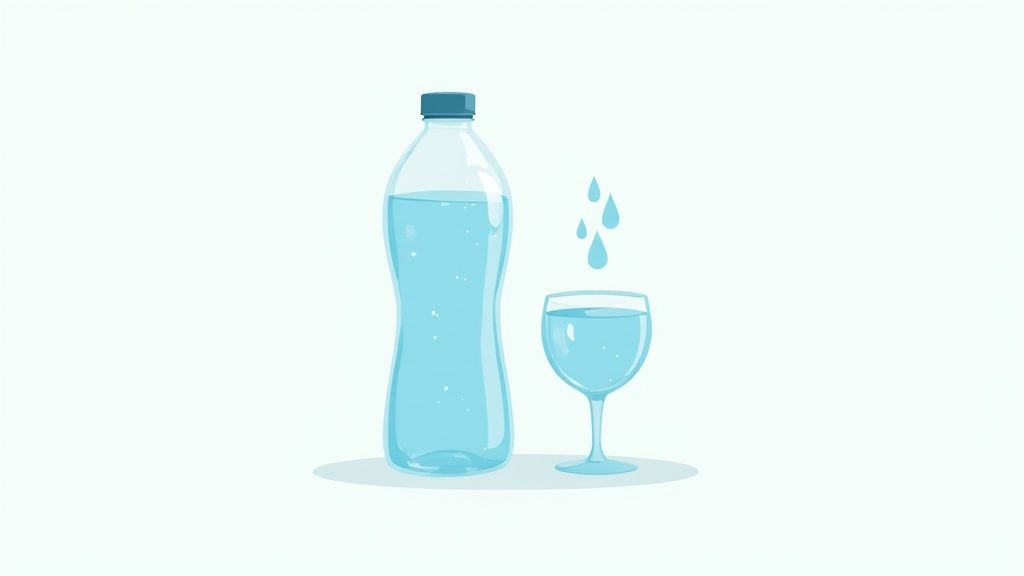How to Avoid Sugar Cravings and Reclaim Your Health

It’s that classic 3 PM slump. You’re not really hungry, but suddenly, the thought of a cookie or a candy bar feels less like a want and more like a need. If this sounds familiar, you're not alone, and it's definitely not a sign of weak willpower. That powerful urge is a complex signal your body and brain are sending, and figuring out what it means is the first real step to getting a handle on it.
This isn't just about what you're eating. It's about digging into the why.
Why You Crave Sugar and How to Stop It
Most of the time, that intense desire for something sweet comes down to a potent mix of biology and psychology. When these two forces work together, they create a cycle that can feel impossible to break. But once you see the pattern, you can start to dismantle it.
The Biological Rollercoaster
From a purely physical standpoint, a sugar craving is often your body trying to correct an imbalance. When you eat something high in sugar or simple carbs, your blood sugar shoots up. Your body responds by releasing a flood of insulin to quickly shuttle that sugar into your cells.
The problem is, this process can be a little too efficient, causing your blood sugar to plummet shortly afterward. That crash is what sends your brain into panic mode. Desperate for a quick energy boost, it sends out an urgent memo: EAT SUGAR NOW! I used to fall victim to this every single afternoon until I realized my light, carb-heavy lunch was setting me up for that exact crash-and-crave cycle.
Psychological Triggers and Deep-Rooted Habits
Of course, it’s rarely just about blood sugar. Your mind plays a huge part in this, tying cravings to specific emotions, places, and routines.
- Stress: Feeling overwhelmed? Your body releases cortisol, a stress hormone that cranks up your appetite for the exact "comfort" foods you're trying to avoid—high in sugar and fat.
- Habit: If you’ve always ended your day with a bowl of ice cream in front of the TV, your brain learns to expect it. The TV show itself becomes the trigger.
- Boredom: Sometimes, a craving is just your brain looking for a distraction from a task you'd rather not be doing. That trip to the vending machine is much more interesting than finishing that report.
It’s impossible to overstate how critical the psychological side is. Research shows that when we're under chronic stress, our elevated cortisol levels literally make us prefer sugary foods as a way to self-soothe. In fact, one study found that people who participated in a mindfulness-based stress reduction program saw their sugar cravings drop by an incredible 35%.
Think of yourself as a detective. Start noticing when and where your cravings strike. Is it always after a stressful meeting? Or when you walk past that one bakery on your way home? Once you identify your personal triggers, you can start creating a real plan to sidestep them.
For more on this, you might find our detailed guide on how to reduce sugar cravings really helpful.
Build Meals That Prevent Cravings Naturally
The best way to deal with sugar cravings is to stop them from ever showing up in the first place. This isn't about gritting your teeth and relying on willpower. It's about smart eating—building meals that work with your body, not against it, to keep you feeling full, energized, and genuinely satisfied for hours. The secret is all in what you put on your plate.
When your meals are properly balanced, you sidestep those dramatic blood sugar spikes and crashes that leave your brain begging for a quick sugar hit. The real goal is to create a slow, steady release of energy that keeps you feeling stable all day long. It's the difference between feeling calm and in control versus constantly battling the urge for something sweet.
The Power Duo: Protein and Fiber
When it comes to keeping sugar cravings at bay, your two best friends at every meal are protein and fiber. I think of them as the anchors for your blood sugar. Eating a meal rich in both forces your body to slow down digestion, which in turn prevents a rush of sugar from hitting your bloodstream all at once.
I learned this lesson the hard way. For years, my go-to breakfast was a bowl of sugary cereal, and like clockwork, I’d hit a massive energy slump mid-morning and head straight for the office vending machine. The moment I swapped that for Greek yogurt with berries and nuts, everything changed. The protein and fiber kept me full and focused right through to lunch. No crash, and more importantly, no craving.
One of the most effective strategies to avoid sugar cravings is to ensure your meals contain adequate protein and fiber. This combination stabilizes blood sugar by slowing down glucose absorption, which directly reduces the desire for sugary foods. Research highlights this effect, with one study showing that participants who increased their fiber intake to 30 grams daily saw a 20% reduction in sugar cravings. You can explore more about global eating habits and their impacts by reviewing the latest data on sugar consumption by country.
Practical Meal-Building Strategies
Putting this into practice is way easier than it sounds. This isn't about a restrictive diet; it’s about making simple, smart additions and swaps to the foods you're already eating.
Here are a few simple ways to pack more protein and fiber into your day:
- For Breakfast: Try adding a scoop of protein powder or a tablespoon of chia seeds to your morning smoothie. If you're an eggs person, have them with a side of black beans and a whole-wheat tortilla instead of white toast.
- At Lunchtime: Make your salad more substantial with a scoop of chickpeas, lentils, or some grilled chicken. If you're having a sandwich, use whole-grain bread and really load it up with lean protein and veggies like spinach or sliced bell peppers.
- Come Dinner: Always try to add a side of roasted vegetables like broccoli or Brussels sprouts. Swap out white rice for a more fibrous grain like quinoa or brown rice, and make sure a quality protein source—think fish, tofu, or lean meat—is the main event.
By focusing on these small, consistent changes, you’re doing more than just eating a meal. You’re building a defense against future cravings. Every balanced plate is another step toward breaking that exhausting cycle and finally taking back control of your energy and health.
How to Snack Smarter and Beat Cravings
Snacking often gets a bad rap, but it can actually be your secret weapon in the fight against sugar. When you do it right, a smart snack keeps your energy stable and holds you over between meals, which is key to shutting down those intense cravings before they even start.
The trick is to ditch the empty-calorie snacks and instead reach for something with a simple, powerful formula: protein + healthy fat + fiber. This combo is the ultimate craving-crusher. It slows down digestion, prevents those notorious blood sugar spikes, and keeps you feeling full and focused for hours.
The Art of the Healthy Swap
Knowing what to grab when a specific craving hits is a total game-changer. Don't think of it as depriving yourself; think of it as a smart upgrade. Your body is sending you a signal, and your job is to give it the real nutrition it needs, not just the quick sugar fix it thinks it wants.
Here are a few practical swaps I use all the time:
- Craving something crunchy and salty? Instead of tearing open a bag of chips, I’ll roast some chickpeas with a little olive oil and smoked paprika. You get that satisfying crunch without the inevitable energy crash.
- Need a creamy, comforting treat? Rather than digging into a pint of ice cream, I’ll mash half an avocado with a pinch of salt or blend some frozen bananas into a delicious "nice cream."
- Fighting a chocolate urge? A single square of high-quality dark chocolate (at least 70% cacao) usually does the trick. It delivers that rich, deep flavor and antioxidants, satisfying the craving without a ton of sugar.
The infographic below breaks down exactly how to build these powerful, craving-fighting snacks.

This visual is a great reminder of how combining things like nuts, berries, and yogurt creates a balanced snack that supports steady energy. The goal is to make these smart choices feel like a natural—and delicious—part of your day.
Smart Snack Swaps to Beat Cravings
Having a plan for those "in-the-moment" cravings makes all the difference. This table gives you some simple, satisfying alternatives for common sugary or processed snacks so you can make a better choice without feeling like you're missing out.
| Instead of This Craving... | Try This Smart Swap... | Why It Works |
|---|---|---|
| Gummy candies or fruit snacks | A small handful of mixed berries (fresh or frozen) | Berries provide natural sweetness with a dose of fiber, which helps manage blood sugar. The vibrant flavor satisfies a sweet tooth. |
| A candy bar | A square of 70%+ dark chocolate and a few almonds | You get the rich chocolate flavor plus protein and healthy fats from the almonds, making it far more satisfying and satiating. |
| Potato chips | Air-popped popcorn with a sprinkle of nutritional yeast | Popcorn is a whole grain that delivers a salty crunch, and nutritional yeast adds a cheesy flavor without the extra fat and sodium. |
| Sugary yogurt | Plain Greek yogurt with cinnamon and a few walnuts | Greek yogurt is packed with protein. Cinnamon helps stabilize blood sugar, and walnuts add a satisfying crunch and healthy fats. |
| A donut or pastry | An apple with a tablespoon of natural peanut butter | This classic combo delivers fiber, protein, and healthy fats. The natural sweetness of the apple paired with the rich peanut butter is surprisingly satisfying. |
Remember, it's not about perfection; it's about making a slightly better choice each time. Over time, these small swaps add up to big results.
Stocking Your 'Craving-Crusher' Pantry
Let's be honest: when you're busy or stressed, you're going to grab whatever is easiest. The best way to outsmart your old habits is to make healthy snacks the most convenient option available.
A common mistake is thinking all "natural" sweeteners like honey or agave are better for you. Your body metabolizes them in the same way as regular sugar. The real win comes from choosing whole foods that offer fiber and nutrients alongside their natural sweetness.
I always keep a few go-to snacks on hand that are ready in minutes. Here are some of my staples:
- Apple slices with a tablespoon of peanut or almond butter
- A small bowl of plain Greek yogurt with a handful of berries
- A handful of almonds and walnuts
- Celery sticks or baby carrots with hummus
Having these options ready to go makes it so much easier to make a good choice when you're hungry. For even more inspiration, check out our list of 9 sugar-free snack ideas to keep your snacking strategy fresh and exciting. This proactive approach helps you manage cravings without ever feeling like you're missing out.
Adopt Lifestyle Habits That Reduce Sugar Cravings

What you eat is a huge part of the equation, but it's not the whole story. If you really want to learn how to sidestep sugar cravings, you have to look at the small, consistent choices you make all day, every day. It's about building a lifestyle that naturally shields you from those sudden, overwhelming urges for sweets.
This means zooming out from your plate to look at the bigger picture. We’re talking about your sleep, how much water you drink, and even the way you think about eating. These habits create a solid foundation for your body and mind, which makes saying "no" to sugar feel a lot less like a battle.
The Critical Role of Quality Sleep
Ever notice how a terrible night's sleep makes you crave junk food the next day? That’s not just in your head. When you're running on fumes, your decision-making skills tank, and your hunger hormones go haywire.
It’s a scientific fact. Sleep deprivation cranks up your body's production of ghrelin (the "I'm hungry" hormone) while suppressing leptin (the "I'm full" hormone). This hormonal mess is the perfect recipe for intense cravings. Your tired brain also loses its impulse control, making that box of donuts at the office nearly impossible to resist.
Ready to improve your sleep? Start tonight with a few simple tweaks:
- Try to go to bed and wake up at the same time every day—yes, even on weekends. This gets your body clock into a steady rhythm.
- Wind down before bed with something relaxing. Read a book, take a warm bath, or do some gentle stretches.
- Power down your screens at least one hour before you plan to sleep. The blue light from phones and tablets messes with your natural melatonin production.
Treating sleep as a non-negotiable part of your health is one of the most effective things you can do to get a handle on sugar.
Think of it this way: a well-rested brain is a rational brain. Research shows that poor sleep makes you far more likely to cave to cravings for high-calorie, sugary foods. Prioritizing rest is like hitting the reset button on your body's natural hunger signals.
Hydration: The Simple Craving Crusher
Sometimes, what feels like a desperate need for a cookie is actually just your body begging for water. The brain signals for thirst and mild hunger come from the same place, so it's incredibly easy to get them mixed up.
Next time a craving hits, try this first: drink a big glass of water and wait 15 minutes. You'll be amazed how often that craving just vanishes. Staying hydrated also keeps your energy levels stable, preventing those afternoon slumps that send you searching for a quick sugar hit.
The easiest trick is to keep a water bottle with you at all times. If you get bored with plain water, toss in some lemon slices, cucumber, or fresh mint. It adds a refreshing kick with zero sugar. For anyone on a mission to cut out sugar, staying hydrated is a must-have tool in your arsenal. You can explore more essential strategies in our guide to starting a sugar detox for beginners.
Practice Mindful Eating
Finally, how you eat can be just as impactful as what you eat. Mindful eating is all about paying full attention to your food and your body, without the TV, your phone, or other distractions getting in the way. It’s a powerful way to reconnect with your body’s real hunger and fullness signals.
Instead of eating out of habit or because you're stressed, you start to pause and ask yourself: "Am I actually hungry? Or am I just bored, tired, or anxious?" That simple moment of reflection can be enough to break the cycle of mindless snacking and reveal the true triggers behind your cravings.
Using Technology to Support Your Journey

In this day and age, your phone doesn't have to be a source of distraction. It can actually be one of your most powerful allies in the fight to eat less sugar. An app like StopSugar is designed to take all the strategies we’ve talked about and turn them into real, lasting habits. Think of it as having a supportive coach right in your pocket.
Instead of just white-knuckling it with willpower, technology can bring some much-needed structure and insight to the process. This is all about making the healthier choice the easier choice, which is the secret sauce for long-term success when you want to stop sugar cravings for good.
Pinpoint Your Triggers with a Craving Tracker
The first real step to breaking any habit is to understand it inside and out. The craving tracker in the StopSugar app is perfect for this. When a powerful craving hits, you don't just have to fight it—you can log it.
Take a second to record what’s happening. What time is it? How are you feeling—stressed, bored, tired? What’s the situation? By doing this, you're gathering clues. After just a week or two, you’ll start to see clear patterns. Maybe you’ll realize your cravings aren't random at all, but are tied directly to that 3 PM energy slump or a stressful weekly meeting.
This kind of insight is a game-changer because it lets you get ahead of the problem. If you know stress is a trigger, you can have a non-food coping plan ready. If boredom is the real culprit, maybe that's your cue to go for a quick walk.
The goal isn't perfection; it's awareness. Tracking transforms that vague, out-of-control feeling around sugar into a clear, manageable problem. Suddenly, you have identifiable triggers and real solutions. You're replacing guesswork with data.
Use Your Data to Build a Stronger Defense
Once you start seeing those patterns, you can build a truly personalized defense plan. The dashboard visualizes when cravings strike most often, helping you anticipate and prepare for those high-risk moments. This data-driven approach means you can finally shift from just reacting to cravings to actively preventing them.
An app can also provide critical support right when you need it most. Many include features that can make all the difference, like:
- A Recipe Database: Instantly find meal and snack ideas packed with protein and fiber to keep your blood sugar stable. No more frantic searching for something healthy to eat.
- Progress Tracking: Nothing beats the motivation of seeing a streak of sugar-free days grow. It’s a powerful visual reminder of how far you’ve come.
- Personalized Reminders: Set up notifications to drink a glass of water, prep a healthy snack before a known energy dip, or just take a deep breath during a stressful moment.
By weaving these tools into your daily life, you turn your phone from a potential distraction into a dedicated partner. It helps keep you mindful, prepared, and motivated, which makes the journey to a lower-sugar life feel a whole lot smoother.
Got Questions About Sugar Cravings? We've Got Answers
Taking on your sugar habit is a big step, and it's totally normal to have a ton of questions pop up along the way. Let's tackle some of the most common ones I hear, so you can feel ready and in control.
So, How Long Until These Sugar Cravings Finally Go Away?
This is probably the number one question people ask, and the honest answer is: it's different for everyone. But there's a general pattern. Most people find the really intense, physical cravings start to fade within the first week or two. That's your body recalibrating its blood sugar and getting used to a new normal.
The mental game, though? That can take a bit longer. Emotional habits and routine-based triggers might stick around for a few weeks, or even a couple of months. The real secret is staying consistent. As you build healthier routines, your taste buds literally change, and those old triggers just won't have the same pull. You might even find that super-sweet stuff you used to love doesn't taste so great anymore.
What Do I Do When a Massive Craving Hits?
Okay, so a craving just smacked you in the face. It feels huge, and your first instinct might be to give in or just white-knuckle it. Don't panic. The trick isn't just about willpower; it's about having a smart plan.
First thing to do: grab a big glass of water and wait 15 minutes. Seriously. Our brains are notorious for mixing up thirst signals with hunger or cravings. That short pause is often all you need to figure out what's really going on.
If it's still bugging you after 15 minutes, it's time to pivot. Try one of these go-to moves:
- Move your body. A quick walk, a few jumping jacks, or some simple stretches can completely change your brain chemistry and kill a craving.
- Make a smart swap. Reach for something naturally sweet, like a handful of berries, a crunchy apple, or a single square of good-quality dark chocolate. You get the sweet fix, but with fiber and nutrients.
- Create a distraction. Cravings are powerful but often have a short attention span. Put on your favorite song, call a friend, or knock out a quick five-minute chore. By the time you’re done, the craving has often passed.
A craving is just a suggestion, not a command. You don't have to obey it. By taking a moment to respond instead of reacting, you're training your brain and body that you're in charge.
Are Artificial Sweeteners a Good Stand-In for Sugar?
It's a common thought: just swap sugar for those zero-calorie packets, right? While it sounds like a perfect solution, it's a bit more complicated than that. I usually advise people to be careful with them.
Here's why: research suggests that these super-sweet substitutes can kind of trick your brain. You taste something intensely sweet, so your body expects a rush of energy (calories), but then nothing shows up. This mismatch can mess with your body's natural hunger cues and, ironically, might even make you crave real sugar more later on.
A better long-term strategy is to focus on re-training your palate. Instead of searching for substitutes, learn to enjoy the subtle, natural sweetness found in whole foods. A little cinnamon in your coffee or the natural sweetness of roasted vegetables can be surprisingly satisfying once your taste buds adjust. It's a much more sustainable way to build a healthier relationship with food.